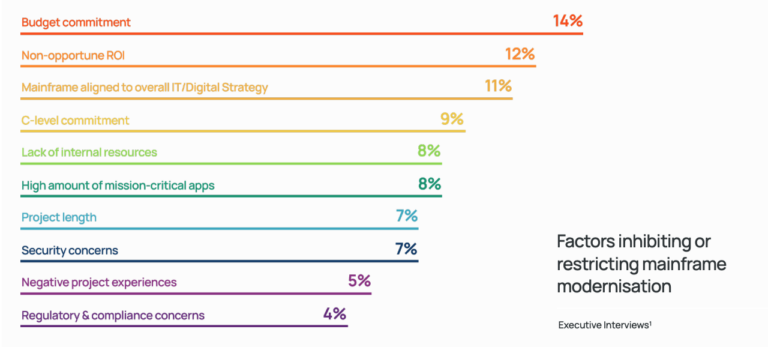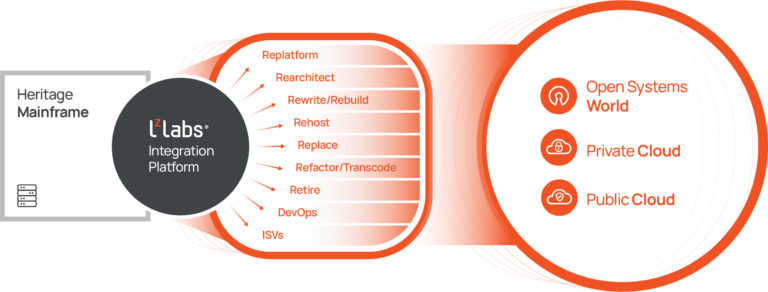Whitepaper: Is the Mainframe Your Innovation Platform?
Moving off the mainframe is not an easy undertaking. While there are good reasons to keep some applications and data where they are, strong business drivers call for legacy modernisation and transformation today.
Download our whitepaper to learn more about the approach that minimises the uncertainty of mainframe migration and connects the legacy with the modern world.
Read the blog below for a summary of some highlights from the whitepaper.
Einstein said, “The measure of intelligence is the ability to change.” However, when it comes to technological adaptability, one of the largest and often scariest changes is the migration from the mainframe to the modern systems of your choice – be it in the Cloud, Hybrid Cloud, or on-premise. When we pose the question to our customers, “Isn’t it time to move away from mainframes?” the answer is almost always “yes, it is”, quickly followed by the word “but…”
A research Whitepaper by LzLabs in 2021 revealed that “more than two-thirds (67%) of decision-makers believe their organisation’s mainframe holds them back in their innovation journey.” But since 96% of respondents surveyed for this research say mainframes are critical to their business, it’s easy to see why change is hard.
Mainframes are ageing, but remain useful
According to the research, 90% believe that it is difficult to customise mainframe applications in order to support innovation objectives and 84% report it’s difficult to build, develop and test applications on the mainframe quickly. At the same time, mainframe applications continue to be extremely critical to organisations and their business operations. In fact, research shows they remain critical as they were years ago.
Clearly, there’s a disconnect between the need for change and the desire, ability or drive to commit to change. Our 2021 survey concluded that modernisation is not happening quickly enough. More needs to be done to help organisations fully commit.
That’s why we updated this research with the latest whitepaper, which describes a balanced approach that integrates the mainframe into the innovation journey, while gradually phasing it out.
Drivers of Mainframe Modernisation
Using the mainframe as a platform must evolve, and it is evolving. According to a study we conducted in 2022 with a large international research firm, mainframe migration projects are expected to grow by 16% compound annual growth rate. Why? Because of drivers that have little to do with the mainframe, and everything to do with future potential earnings and business evolution. According to our 2022 research, these drivers are: cost reduction, skills attrition, agility, innovation and security.
Business and technology leaders agree: it’s time to innovate. They call for flexible technology. For example, one Digital Transformation Leader at a Manufacturing company said, “Companies migrating off mainframe are doing so to get the benefits of the increased speed and business agility, especially for their critical applications.” When it comes to addressing skills shortages, the Head of IT Architecture at a European Private Banking Group concurred, saying: “Maintaining the software ourselves is becoming more difficult, as we see a huge aging and very little young people actually willing to learn these antique programming languages. Thus, we are kind of forced to leave Mainframe, regardless of the investments required.”
Why aren’t more people moving off the mainframe?
While migration and transformation projects can exceed millions of Euros, it’s hardly surprising that the research from our 2022 survey indicated that 14% see project budget commitment for mainframe migration as the key inhibitor. It’s perceived as an expensive, long-term project.

However, it doesn’t have to be. Legacy transformation can, in fact, become an accelerator of new initiatives. By finding the right technology to support the transformation project and working with professionals that guide you through the journey – like LzLabs’ group of legacy technology experts – modernisation can lead to significant innovation.
“The biggest inhibitor to mainframe modernisation is actually around awareness of what is running on those platforms, how are those applications fitting together?”
− Global Black Belt, Mainframe Transformation −
Half the battle lies in figuring out what needs to be replaced, and what doesn’t. Modernising existing setups doesn’t mean they need to be replaced entirely. In fact, many aspects of an organisation’s technology architecture are there for a good reason and remain critical to core processes.
Doing legacy modernisation safely and securely
We understand that modernisation is complex and risky. That’s why the most successful companies are carefully undertaking legacy modernisation safely and securely, while retaining essential parts of their IT infrastructure and placing them in improved environments. Making changes with as few moving parts as possible helps achieve innovation whilst maintaining business continuity.
The right modernisation strategy enhances agility, rather than imposing a pre-determined architecture upon organisations. Those that act assertively but with consideration, using a methodical approach to change, will position themselves well for long-term success – and leverage the mainframe as the framework of a platform for innovation, rather than a reason to ignore change.

Want to know more?
Download our whitepaper, “Is the Mainframe your platform of innovation?” to find out more about digitisation, legacy and the future of application modernisation and you’ll discover how to remove the uncertainty of mainframe migration. We are also hosting regular webinars that provide you with insight into successful off-mainframe migration strategies and real projects.